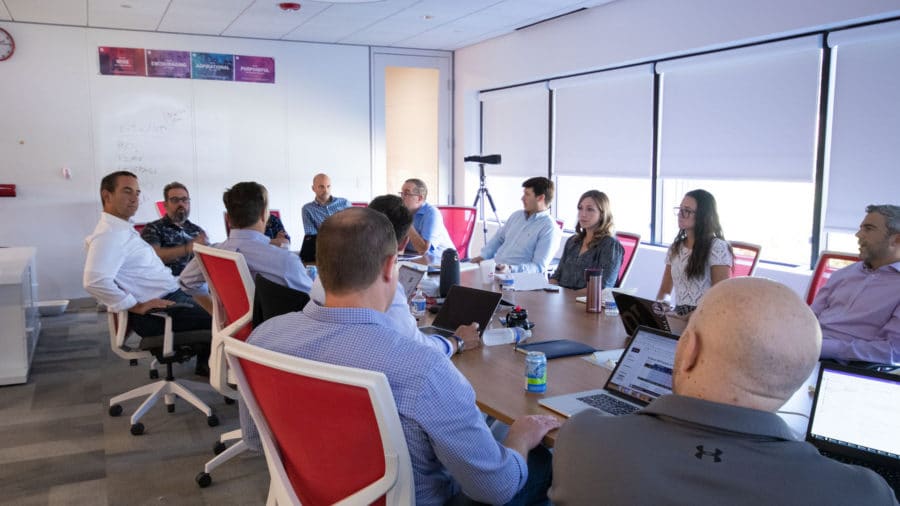Once your client has established their business strategy, it’s imperative their talent strategy align with it. Whether it’s prompted by a newly-designed organizational structure or more strategic talent mapping, your client will likely be adding to (or subtracting from) their current teams.
Through all these changes, ask yourself: Does my client fully understand how much things are going to change? Can I show them exactly how?
Yes, you can predict new team dynamics. But it’s a self-fulfilling prophecy.
Your client may be used to hiring and hoping for the best: They have a job opening, they find candidates with the right skills, and they make the hire. But they don’t necessarily think about the potential impact of that hiring decision. If your client has resigned to the idea that hiring is a crapshoot, you can show them otherwise.
When it comes to hiring new employees or transferring existing employees on to new teams, your client needs to be prepared how the shift will impact team dynamics. While you may not be making hiring decisions for your client, you can help prepare them to make the right ones.
There are three essential steps to predicting new team dynamics:
1. Make sure your client understands it’s not just about bringing on the right skill set.
The right skill sets are certainly necessary to drive business results. But it shouldn’t be the only—nor the primary—factor in your client’s decision to hire a candidate.
Behavioral and cognitive data can give tremendous insight to how successful a new hire may be in their role. For example, if a job demands that an employee pay close attention to detail and deliver error-free work, someone who isn’t behaviorally driven to precision will not be a good fit. From a cognitive standpoint, if a role demands that someone be quick to learn new concepts and adapt to frequent change, those who possess a higher cognitive ability will likely do well, while those with a lower cognitive ability may struggle to succeed.
Yet as crucial as individual behavioral and cognitive fits are to success in a given role, it’s even more important to consider how the individual’s behavioral needs and drives will work within the context of a team.
2. Use data to give your client a better team dynamics benchmark—and make the right hiring decisions.
Your client can’t begin to understand the potential impact of a new team member without first understanding the existing team dynamics. That benchmark will guide your client when it comes to figuring what’s needed to maintain or drive high performance.
Behavioral data is your starting point. When clients have a clear picture of how each team member is wired and how they work together, they can make more strategic decisions. For instance, if a team is made up of employees who are risk-tolerant, who like to drive things forward quickly, and who are naturally extraverted, introducing a new team member who is the complete opposite might seem like a risk. But that doesn’t have to be the case. Your client can work with the existing team and the new hire to understand how they are different from each other, how they can adapt, and why that behavioral diversity will add value to the team.
Hiring the right behavioral fit to a team in addition to skill set is important to driving results. But that doesn’t mean the team should be homogeneous—in fact, it should be anything but. What’s important, though, is that your client go in with eyes wide open, fully understanding the existing dynamic, and thinking critically about the positive (or potentially negative) effects of changing it.

3. Don’t sugar coat it: When your client adds a new team member, they create a new team.
And that’s not a bad thing. You can empower your client to make the right hiring decisions so the new team is even more engaged and higher performing.
Here are two aspects of the team that may change:
Communication style
If the current team operates with a free-flowing, open style of communication, bringing on someone who’s more reserved will alter the dynamic. Existing team members may feel they need to hold back, or the new team member may too often stretch outside their comfort zone to fit in. Anticipating these changes will help clients teach their teams how to better communicate with each other from the outset.
Decision making
For teams that are quick to act and operate with a high level of autonomy, a new team member who values process and double-checking with someone in a position of authority before executing may give off the impression of slowing things down. Clients will do well to make sure the team understands the value this new hire brings to the team, so misunderstandings don’t create tension.
It may seem like a lot for your client to consider just to make a hiring decision, but the fact remains: Hiring is never a one-time action. It has long-lasting implications—both positive and negative. While that may seem daunting, you’re in a position as a consultant to empower your client to not only make the right hiring decision for an individual role, but also help them predict new team dynamics that can mobilize teams to drive business results.
Join 10,000 companies solving the most complex people problems with PI.
Hire the right people, inspire their best work, design dream teams, and sustain engagement for the long haul.



